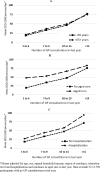Socio-demographic and health service factors associated with antibiotic dispensing in older Australian adults
- PMID: 31465480
- PMCID: PMC6715220
- DOI: 10.1371/journal.pone.0221480
Socio-demographic and health service factors associated with antibiotic dispensing in older Australian adults
Abstract
Background: Widespread use of antibiotics has led to the development of antibiotic resistance. However, there are limited data describing antibiotic use in the community setting, and examining factors associated with greater use. Our study aimed to quantify antibiotic dispensing in older adults in the community according to socio-demographics and health services use.
Methods: Prospective analysis of a population-based cohort study of 239,981 adults aged ≥45 years in Australia (the Sax Institute's 45 and Up Study). Data on socio-demographics and health from a questionnaire, were linked to 2015 antibiotic dispensing data from the Pharmaceutical Benefits Scheme (PBS), as well as other administrative health databases. We estimated the Defined Daily Dose (DDD) of systemic antibiotics dispensed, defined by an Anatomic Therapeutic Classification code beginning with J01, in 2015. We also conducted Poisson regression with robust standard errors to identify factors associated with antibiotic dispensing.
Results: Overall, 49.3% of 45 and Up Study participants had at least one systemic antibiotic dispensed in 2015 with a total of 392,856 prescriptions dispensed and an average of 36.5 DDDs/1000-persons/day in the study population. The quantity of antibiotics dispensed increased with increasing age (25.6 DDDs/1000/day in <60 years old versus 50.4 DDDs/1000/day in 80+ year old) and was higher comparing women to men (39.9 versus 32.4 DDDs/1000/day). Of factors examined, the greatest dispensing of antibiotics was among those who had been resident in an aged care facility and those with >15 general practitioner consultations in the last year (80.5 and 88.3 DDDs/1000/day, respectively). These factors remained strongly associated with greater antibiotic dispensing after adjusting for age, sex, education, income, area of residence and co-morbidities.
Conclusions: Residence in aged care facilities and high GP visits are associated with greater antibiotic dispensing. This study provides important evidence regarding high use groups for antimicrobial stewardship.
Conflict of interest statement
The authors have declared that no competing interests exist.
Figures
Similar articles
-
Microbiology testing associated with antibiotic dispensing in older community-dwelling adults.BMC Infect Dis. 2020 Apr 25;20(1):306. doi: 10.1186/s12879-020-05029-z. BMC Infect Dis. 2020. PMID: 32334518 Free PMC article.
-
Prescription opioid dispensing in New South Wales, Australia: spatial and temporal variation.BMC Pharmacol Toxicol. 2018 Jun 18;19(1):30. doi: 10.1186/s40360-018-0219-0. BMC Pharmacol Toxicol. 2018. PMID: 29914572 Free PMC article.
-
Antibiotic Use Associated with Confirmed Influenza, Pertussis, and Nontyphoidal Salmonella Infections.Microb Drug Resist. 2020 Dec;26(12):1482-1490. doi: 10.1089/mdr.2020.0017. Epub 2020 Apr 21. Microb Drug Resist. 2020. PMID: 32315565
-
Determinants of antibiotic dispensing without prescription: a systematic review.J Antimicrob Chemother. 2018 Dec 1;73(12):3244-3253. doi: 10.1093/jac/dky319. J Antimicrob Chemother. 2018. PMID: 30137342
-
The causes and effects of socio-demographic exclusions from clinical trials.Health Technol Assess. 2005 Oct;9(38):iii-iv, ix-x, 1-152. doi: 10.3310/hta9380. Health Technol Assess. 2005. PMID: 16181564 Review.
Cited by
-
Microbiology testing associated with antibiotic dispensing in older community-dwelling adults.BMC Infect Dis. 2020 Apr 25;20(1):306. doi: 10.1186/s12879-020-05029-z. BMC Infect Dis. 2020. PMID: 32334518 Free PMC article.
-
Epidemiological characteristics of antimicrobial use in Primary Care in Spain: a nationwide study.Rev Esp Quimioter. 2025 Mar 3;38(2):115-125. doi: 10.37201/req/120.2024. Epub 2025 Feb 6. Rev Esp Quimioter. 2025. PMID: 39927581 Free PMC article.
References
-
- Australian Commission on Safety and Quality in Health Care (ACSQHC). AURA 2017: second Australian Report on antimicrobial use and resistance in human health. Sydney: ACSQHC; 2017. Available from: https://www.safetyandquality.gov.au/publications/second-australian-repor...
-
- Australian Commission of Safety and Quality in Health Care. Antimicrobial prescribing practice in Australian hospitals: results of the 2014 National Antimicrobial Prescribing Survey. Sydney: ACSQHC; 2015. Available from: https://www.safetyandquality.gov.au/wp-content/uploads/2015/07/Antimicro...
-
- Lim CJ, Stuart RL, Kong D. Antibiotic use in residential aged care facilities. Aust Fam Physician. 2015;44:192–196. - PubMed
-
- National Centre for Antimicrobial Stewwardship. Antimicrobial prescribing and infections in Australian residential aged care facilities Australian Commission on Safety and Quality in Health Care. ACSQHC; 2016. Available from: https://www.safetyandquality.gov.au/wp-content/uploads/2017/01/Antimicro...
Publication types
MeSH terms
LinkOut - more resources
Full Text Sources
Research Materials



